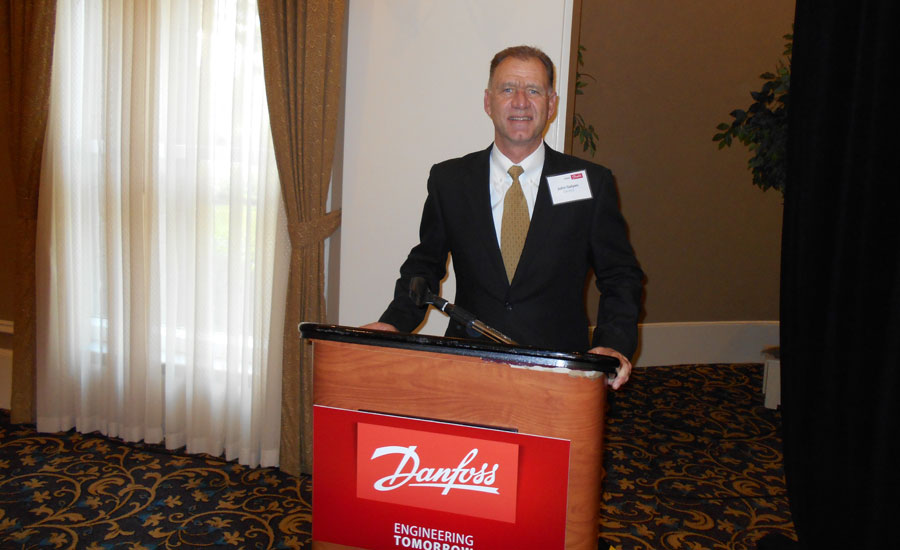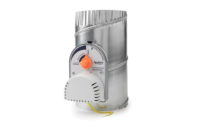Danfoss hosted its 21st annual press briefing Jan. 26 during the 2016 AHR Expo in Orlando, Florida. Titled “Engineering Tomorrow,” this year’s briefing explored four major challenges facing the HVACR industry — climate change, energy productivity, connectivity, and a growing skills gap.
Danfoss North America President John Galyen opened the briefing by looking at each of the four challenges, beginning with climate change. He highlighted Danfoss’ global expertise in hydrocarbon (HC), carbon dioxide, and other low-global warming potential (GWP) alternatives across a wide portfolio of products that positions Danfoss to support the phasedown of hydrofluorocarbons (HFCs). Galyen said the company is leading a codes and standards task force to accelerate the adoption of low-GWP refrigerants, including those that are flammable or mildly flammable.
Regarding energy productivity, Galyen outlined what the HVACR industry requires to meet the goal of doubling energy productivity by 2030.
“We need supportive regulations; a focus on renewables; demand response and energy storage that will redefine the grid-building relationship; broader deployment of existing energy-efficient technologies; and a whole-building approach that uses smart components in a smart system, integrated in smart buildings connected to a smart grid,” Galyen said.
He went on to say that retrofitting the vast existing building stock provides the greatest opportunity to reduce energy use in buildings.
In discussing the industry-wide skills gap, Galyen cited Bureau of Labor statistics that project nearly 50 percent of HVACR contractors will retire over the next 10 years.
“Closing the workforce gap will require close industry-wide collaboration, along with innovation and planning today for where we need to be in the future,” he said.
Mark Menzer, director of public affairs at Danfoss, followed Galyen and provided an update on energy efficiency and refrigerant regulations, including reports on the recent COP 21 agreement and progress among parties to the Montreal Protocol to reach an agreement on a global HFC phasedown. Turning to the Climate Plan, he described the Clean Power Plan as its cornerstone, designed to lower power plant emissions by 32 percent by 2030.
“As a result, we are working with some key states to assure that energy efficiency technologies, such as variable-speed drives in industry and super-efficient air conditioning and refrigeration systems, become part of their plans,” he said.
Regarding the phasedown of HFCs, Menzer noted that in 2016 the U.S. Environmental Protection Agency (EPA) will turn its attention to chillers, food processing facilities, and refrigerated warehouses.
“We expect to see a proposed rule soon, at least phasing out R-134a and R-410A in chillers, replaced by hydrofluoroolefin (HFO) blends,” he said.
Meanwhile, Menzer reports Danfoss is continuing to facilitate an industry task force to accelerate the adoption of building codes that allow for the use of A2L refrigerants.
Looking ahead to 2016, Menzer sees a push for a Montreal Protocol agreement along with a trend toward renewables and a growing need for energy storage on the grid. He also anticipates commercial food service establishments will find much of their new equipment will use alternative refrigerants, and expects to see new testing procedures and efficiency rules from the U.S. Department of Energy (DOE).
Press briefing attendees also heard Jonathan Holloway, strategic marketing director at Danfoss, describe several Danfoss next-generation solutions, particularly as they relate to efficiency, refrigerants, and connectivity. With respect to efficiency, Holloway noted that Danfoss’ expertise extends to more than two-thirds of the component content of a chiller, adding, “We are equipped to surround our customers’ systems with application experts to design and optimize systems to meet the future standards.”
Describing Danfoss as a connectivity enabler, Holloway went on to say the company offers components that modulate based on data, with communication within and outside a system. He cited the track record Danfoss has established in the food service industry as an example of the company’s connectivity experience.
“In a connected supermarket, Danfoss sensors are feeding data to Danfoss electronic controllers and Danfoss drives,” he said. “These drives use data locally to dynamically match load requirements and operate Danfoss valves to ensure food safety and system efficiency and send data to Danfoss monitoring centers to help drive decisions, including when to dispatch a technician, when to handle an issue remotely and even when to trigger a demand response event to support grid resilience and help retailers save money.”
In the session’s final presentation, Charles Fletcher, executive vice president, EMCOR Services Mesa Energy Systems, described several case studies that highlight energy-efficient retrofits in buildings. Among them was last year’s winner of the Danfoss EnVisioneer of the Year award — a 154,530-square-foot commercial office building in MacArthur Plaza, Irvine, California. The installation of VFDs, high-efficiency motors on two supply fans, and upgraded controls has reduced the building’s energy consumption by more than 478,000 kWh, for a savings of $96,000.
Recapping the presentations, Galyen said, “On the climate front, globally, we see progress in Paris and domestically, in [President] Obama’s Climate Action Plan. We see a rapid pace of regulatory change in efficiency and refrigerants, and connectivity is changing how systems are applied. Given the overlapping regulatory timetables and changing customer needs, it’s critical to address the challenges of increasing efficiency, applying new refrigerants and enabling connected solutions with a holistic, system approach.”
Galyen concluded by underscoring Danfoss’ commitment to helping the HVACR industry stay ahead of megatrends and describing the many ways in which Danfoss is responding to the challenges the industry faces, investing in new products and integrated solutions as well as deep product and application expertise, bolstered through the investment in the company’s new Engineering Tomorrow Application Development Center.










